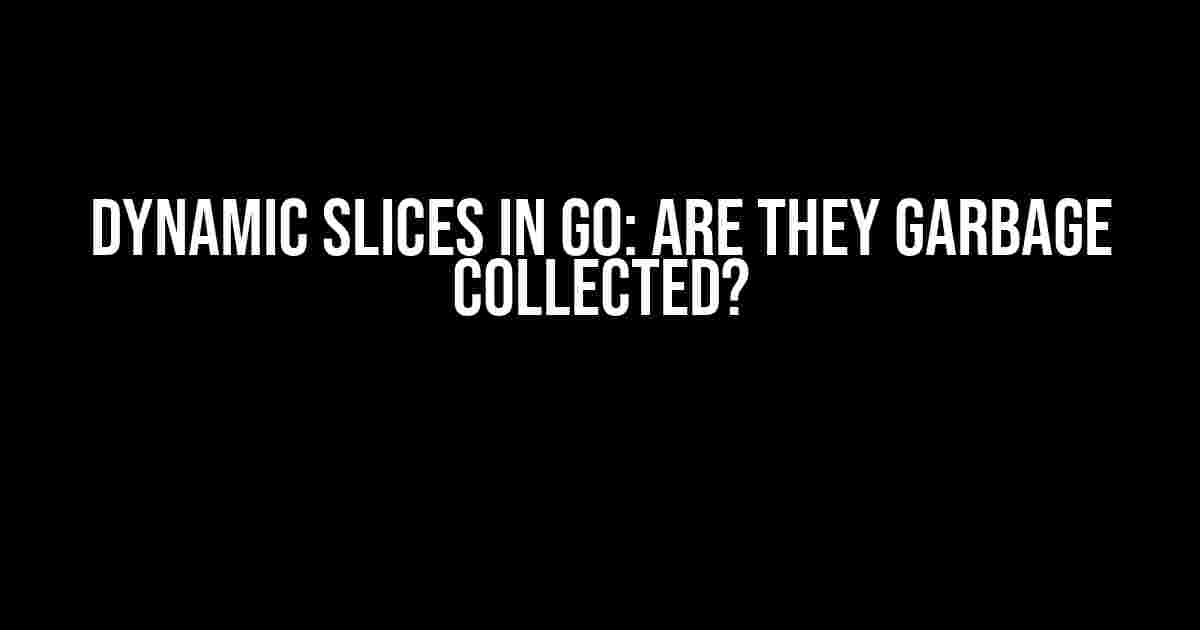As a Go developer, you’ve probably worked with slices and wondered about their memory management. In this article, we’ll dive into the world of dynamic slices in Go and explore whether they’re garbage collected or not.
What are Dynamic Slices in Go?
In Go, a slice is a dynamically-sized, flexible view into the elements of an array. Unlike arrays, slices can grow or shrink in size as elements are added or removed. This flexibility makes slices a fundamental data structure in Go programming.
A dynamic slice is a slice that’s created at runtime, rather than at compile time. This means that the size of the slice is determined by the program’s execution, rather than by a fixed declaration.
Example of a Dynamic Slice
package main
import (
"fmt"
)
func main() {
var mySlice []int
for i := 0; i < 5; i++ {
mySlice = append(mySlice, i)
}
fmt.Println(mySlice) // [0 1 2 3 4]
}
In this example, the size of the `mySlice` slice is determined at runtime by the `for` loop. The `append` function is used to dynamically add elements to the slice, making it a dynamic slice.
How Does Garbage Collection Work in Go?
Go has a built-in garbage collector (GC) that automatically manages memory allocation and deallocation for your program. The GC identifies memory that's no longer referenced and reclaims it, preventing memory leaks and crashes.
The Go GC uses a mark-and-sweep algorithm, which works in three phases:
- Mark phase: The GC identifies all reachable objects (i.e., objects that are referenced by the program) and marks them as live.
- Sweep phase: The GC identifies all unmarked objects and frees their memory.
- Compact phase (optional): The GC compacts the heap to remove holes and make it more efficient.
Are Dynamic Slices Garbage Collected?
The short answer is: yes, dynamic slices are garbage collected in Go!
When you create a dynamic slice, the Go runtime allocates memory for the underlying array. As you add or remove elements from the slice, the runtime updates the slice's metadata to reflect the changes. When the slice is no longer referenced by the program, the GC identifies it as garbage and reclaims its memory.
This means that you don't need to manually manage memory for dynamic slices, as the GC takes care of it for you. This is one of the key benefits of using Go!
But What About the Underlying Array?
When you create a dynamic slice, the underlying array is allocated on the heap. The slice's metadata, including its length and capacity, is stored on the stack. When the slice is resized, the runtime may allocate a new underlying array and copy the existing elements to it.
The underlying array is also garbage collected, but with a twist. The GC doesn't immediately reclaim the memory of the underlying array when the slice is resized or goes out of scope. Instead, the runtime uses a technique called "arena allocation" to manage the memory.
Arena allocation works as follows:
- The runtime allocates a large chunk of memory, called an arena, to store the underlying arrays.
- When a dynamic slice is created or resized, the runtime allocates memory from the arena for the underlying array.
- When the slice is garbage collected, the runtime returns the memory to the arena, but doesn't immediately reclaim it.
- The arena is periodically cleared by the GC, which reclaims the memory and reduces memory fragmentation.
This approach helps reduce memory allocation and deallocation overhead, making Go's slice operations more efficient.
Best Practices for Working with Dynamic Slices in Go
Now that you know dynamic slices are garbage collected in Go, here are some best practices to keep in mind when working with them:
- Use slices instead of arrays whenever possible, as they provide more flexibility and are more efficient.
- Avoid using large, fixed-size arrays, as they can lead to memory waste and fragmentation.
- Use the `len` and `cap` functions to monitor the size and capacity of your slices, and adjust them as needed.
- Use the `append` function to dynamically add elements to your slices, rather than manually managing memory.
- Avoid retaining references to slices or their underlying arrays, as this can prevent garbage collection and lead to memory leaks.
By following these best practices, you can write efficient and safe Go code that takes advantage of the language's built-in garbage collection and slice management features.
Conclusion
In this article, we explored the world of dynamic slices in Go and answered the question: are they garbage collected? The answer is a resounding yes! Dynamic slices are garbage collected, and the Go runtime takes care of memory management for you.
We also delved into the inner workings of Go's garbage collector, arena allocation, and best practices for working with dynamic slices. By following these guidelines, you can write efficient, safe, and scalable Go code that takes advantage of the language's unique features.
So go ahead, create those dynamic slices, and let Go's garbage collector take care of the rest!
| Dynamic Slice | Is it Garbage Collected? |
|---|---|
| Yes | Yes |
Remember, in Go, dynamic slices are garbage collected, so you can focus on writing great code without worrying about memory management!
Frequently Asked Question
In the realm of Go programming, dynamic slices can be a bit tricky to understand when it comes to garbage collection. Let's dive into the FAQs and uncover the truth!
Are dynamic slices garbage collected in Go?
Yes, dynamic slices are garbage collected in Go. When a slice is created, it is stored on the heap, and the garbage collector takes care of freeing up the memory when it's no longer in use. This means that you don't need to manually manage the memory, and you can focus on writing awesome code!
How does the garbage collector know when to free up the memory?
The garbage collector uses a mark-and-sweep algorithm to determine which objects are still reachable from the roots (global variables, stack variables, and registers) and marks them as live. Any objects that are not marked as live are considered garbage and their memory is freed. In the case of dynamic slices, if there are no more references to the slice, it will be garbage collected.
Can I force the garbage collector to run at a specific time?
No, you can't force the garbage collector to run at a specific time in Go. The garbage collector runs concurrently with your program, and it's schedules are determined by the runtime. However, you can use the `runtime.GC()` function to request a garbage collection, but it's not a guarantee that it will happen immediately.
What happens if I have a large dynamic slice that's no longer needed?
If you have a large dynamic slice that's no longer needed, it's a good idea to set the slice to `nil` to release the memory. This will allow the garbage collector to free up the memory as soon as possible. Additionally, you can use the `runtime/debug.FreeOSMemory()` function to release the underlying memory back to the OS, but use it sparingly as it can be expensive.
Are there any performance considerations when using dynamic slices?
Yes, there are performance considerations when using dynamic slices. Since dynamic slices are stored on the heap, they can lead to increased garbage collection overhead, especially if you're creating and discarding large slices frequently. To mitigate this, use slices wisely, and consider using stack-based data structures or pre-allocating slices when possible.


